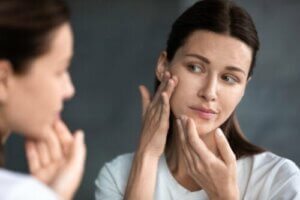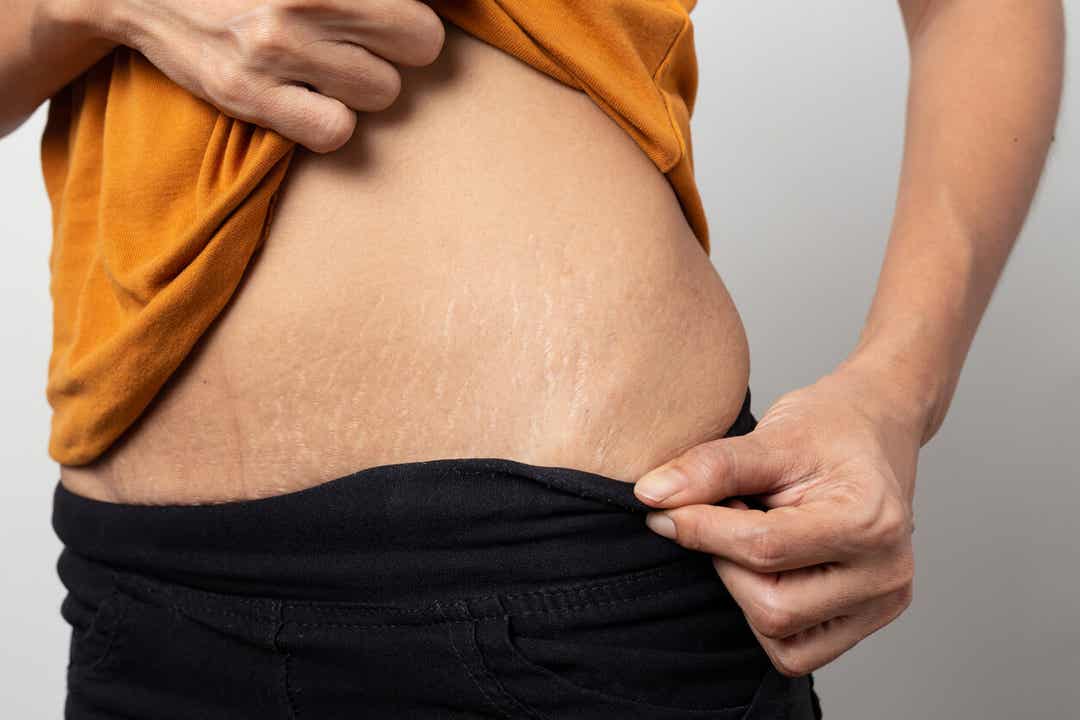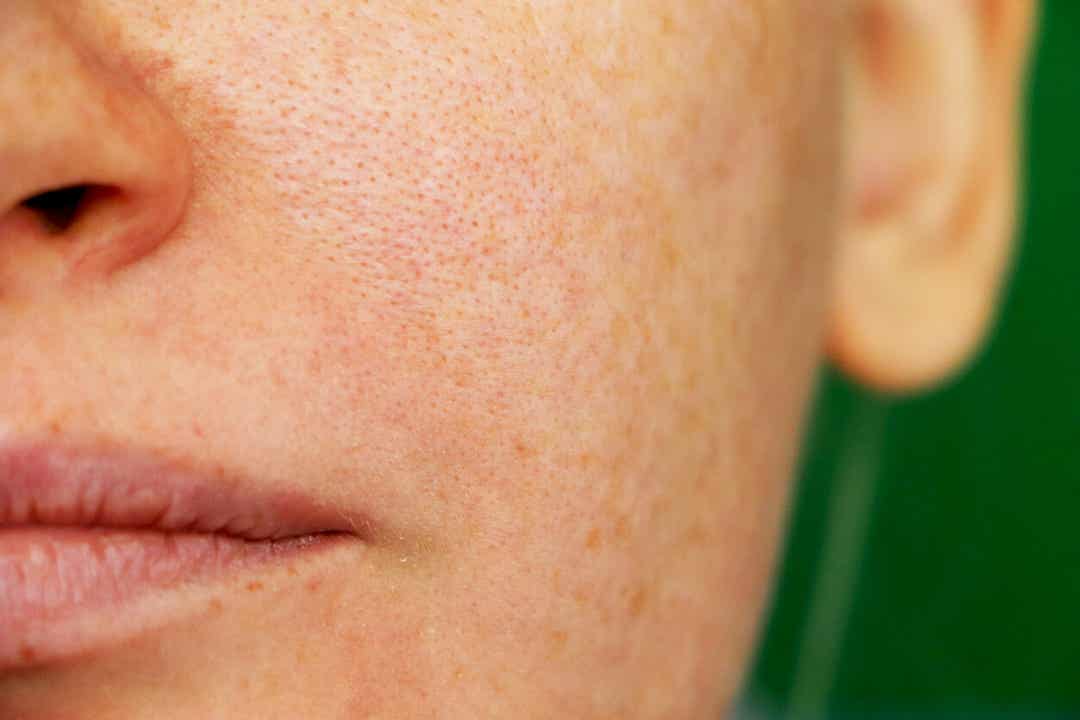How Do Hormonal Changes Affect the Skin After Childbirth?


Written and verified by the dermatologist Maria del Carmen Hernandez
The skin after childbirth undergoes important modifications as a result of the hormonal changes of pregnancy. In fact, skin changes are the most noticeable because they’re more exposed. For this reason, they’re one of the manifestations that most afflict postpartum mothers. Here are some of these changes.
Skin changes after childbirth
Metabolic, endocrine, and immunological alterations cause changes in the skin surface. From dry skin, the appearance of soft fibroids and seborrheic keratoses, to those annoying stretch marks.
Increased dark circles under the eyes
In the postpartum period, a woman’s levels of fatigue are so high that she can see changes in her physical appearance. One of these is the increase of dark circles under the eyes. After childbirth, dark circles under the eyes appear due to hormonal changes, exhaustion, or the intense activity that the new life after pregnancy brings.
Naturally, the hours a woman can rest will decrease, her responsibilities and stress levels increase. All of this contributes considerably to a tired appearance and more noticeable dark circles under her eyes.
Read also: The Importance of Vitamin A in Children and Pregnant Women
Hormonal changes: the presence of striae gravidarum, or stretch marks

Stretch marks can appear due to distension and alteration of the dermal connective tissue. This is a result of hormonal influences, genetics, and physical stretching of the skin. They affect 63 percent of pregnant women, mostly between the sixth and seventh months of pregnancy.
They’re characterized by violet or pink atrophic bands along the tension lines of the skin, mostly on the abdomen, breasts, hips, thighs, and buttocks. Over time, stretch marks become paler and less noticeable but don’t disappear completely.
Types of stretch marks
Stretch marks occur due to abrupt stretching of the skin on any part of the body. Stretch marks can take on different appearances, which include:
- Pink stretch marks: those that were generated more recently and, when the skin tissue breaks, the underlying blood vessels are exposed. They’re also easier to treat and manage because of their short evolution. The constant and daily use of moisturizing creams helps considerably with their improvement.
- Pearly or white stretch marks: white stretch marks are already fibrous scars on the skin’s surface. Therefore, their evolution time is longer and they require a different and more dedicated treatment.
Hyperpigmentation spots, another way hormonal changes affect the skin after childbirth
One of the most notorious skin changes and one that women talk to most with their dermatologists after childbirth is hyperpigmentation. These spots develop in 90 percent of pregnant women, in most cases, in the second half of pregnancy.
Hyperpigmentation’s attributed to a combination of multiple factors:
- Hormonal alterations
- Genetic predisposition
- Exposure to ultraviolet rays
It not only appears as chloasma–hyperpigmentation on the cheeks, forehead, nasal bridge, and upper lip region–but also increases pigmentation on the areolas, genitals, armpits, periumbilical area, and inner thighs.
Hormonal changes: mask of pregnancy
Melasma’s a very common skin problem caused by symmetrical, brown patches on the face. While pregnancy’s one of the main causes of melasma, it can affect women taking oral contraceptives or hormones.
The most important aggravating factor is exposure to sunlight, which is why it occurs in areas such as the face. In this sense, sun protection during pregnancy is essential. In other words, pregnant women must avoid exposure to ultraviolet and visible rays in order to prevent outbreaks or exacerbation.
The use of broad-spectrum sunscreens combined with visible light blockers, such as iron oxide, is recommended every day. Likewise, sunscreen should be reapplied every two hours in case of continued sun exposure.
You may be interested in: Can You Have Laser Hair Removal While Pregnant?

Acne lesions
It’s often common to find pregnancy acne due to excessive activity of the sebaceous glands and hormonal alterations that cause mild outbreaks. The presence of the characteristic lesions of this pathology is usually more evident during the first and second trimesters.
This occurs because of the increase in androgens, which increases the size of the sebaceous glands of the skin and produces more sebum. Therefore, the increased sebum causes clogged pores and leads to inflammation, bacteria, and breakouts.
Acne that develops during pregnancy and after childbirth is usually temporary and disappears when hormone levels normalize.
Hormonal changes and skin changes after childbirth
The physiological alterations that occur during pregnancy are a consequence of metabolic and hormonal adaptations that are necessary to support the developing fetus. The treatment of these benign skin changes is predominantly aesthetic. New mothers should be offered appropriate reassurance and anxiety prevention.
The skin after childbirth undergoes important modifications as a result of the hormonal changes of pregnancy. In fact, skin changes are the most noticeable because they’re more exposed. For this reason, they’re one of the manifestations that most afflict postpartum mothers. Here are some of these changes.
Skin changes after childbirth
Metabolic, endocrine, and immunological alterations cause changes in the skin surface. From dry skin, the appearance of soft fibroids and seborrheic keratoses, to those annoying stretch marks.
Increased dark circles under the eyes
In the postpartum period, a woman’s levels of fatigue are so high that she can see changes in her physical appearance. One of these is the increase of dark circles under the eyes. After childbirth, dark circles under the eyes appear due to hormonal changes, exhaustion, or the intense activity that the new life after pregnancy brings.
Naturally, the hours a woman can rest will decrease, her responsibilities and stress levels increase. All of this contributes considerably to a tired appearance and more noticeable dark circles under her eyes.
Read also: The Importance of Vitamin A in Children and Pregnant Women
Hormonal changes: the presence of striae gravidarum, or stretch marks

Stretch marks can appear due to distension and alteration of the dermal connective tissue. This is a result of hormonal influences, genetics, and physical stretching of the skin. They affect 63 percent of pregnant women, mostly between the sixth and seventh months of pregnancy.
They’re characterized by violet or pink atrophic bands along the tension lines of the skin, mostly on the abdomen, breasts, hips, thighs, and buttocks. Over time, stretch marks become paler and less noticeable but don’t disappear completely.
Types of stretch marks
Stretch marks occur due to abrupt stretching of the skin on any part of the body. Stretch marks can take on different appearances, which include:
- Pink stretch marks: those that were generated more recently and, when the skin tissue breaks, the underlying blood vessels are exposed. They’re also easier to treat and manage because of their short evolution. The constant and daily use of moisturizing creams helps considerably with their improvement.
- Pearly or white stretch marks: white stretch marks are already fibrous scars on the skin’s surface. Therefore, their evolution time is longer and they require a different and more dedicated treatment.
Hyperpigmentation spots, another way hormonal changes affect the skin after childbirth
One of the most notorious skin changes and one that women talk to most with their dermatologists after childbirth is hyperpigmentation. These spots develop in 90 percent of pregnant women, in most cases, in the second half of pregnancy.
Hyperpigmentation’s attributed to a combination of multiple factors:
- Hormonal alterations
- Genetic predisposition
- Exposure to ultraviolet rays
It not only appears as chloasma–hyperpigmentation on the cheeks, forehead, nasal bridge, and upper lip region–but also increases pigmentation on the areolas, genitals, armpits, periumbilical area, and inner thighs.
Hormonal changes: mask of pregnancy
Melasma’s a very common skin problem caused by symmetrical, brown patches on the face. While pregnancy’s one of the main causes of melasma, it can affect women taking oral contraceptives or hormones.
The most important aggravating factor is exposure to sunlight, which is why it occurs in areas such as the face. In this sense, sun protection during pregnancy is essential. In other words, pregnant women must avoid exposure to ultraviolet and visible rays in order to prevent outbreaks or exacerbation.
The use of broad-spectrum sunscreens combined with visible light blockers, such as iron oxide, is recommended every day. Likewise, sunscreen should be reapplied every two hours in case of continued sun exposure.
You may be interested in: Can You Have Laser Hair Removal While Pregnant?

Acne lesions
It’s often common to find pregnancy acne due to excessive activity of the sebaceous glands and hormonal alterations that cause mild outbreaks. The presence of the characteristic lesions of this pathology is usually more evident during the first and second trimesters.
This occurs because of the increase in androgens, which increases the size of the sebaceous glands of the skin and produces more sebum. Therefore, the increased sebum causes clogged pores and leads to inflammation, bacteria, and breakouts.
Acne that develops during pregnancy and after childbirth is usually temporary and disappears when hormone levels normalize.
Hormonal changes and skin changes after childbirth
The physiological alterations that occur during pregnancy are a consequence of metabolic and hormonal adaptations that are necessary to support the developing fetus. The treatment of these benign skin changes is predominantly aesthetic. New mothers should be offered appropriate reassurance and anxiety prevention.
All cited sources were thoroughly reviewed by our team to ensure their quality, reliability, currency, and validity. The bibliography of this article was considered reliable and of academic or scientific accuracy.
- Bieber AK, Martires KJ, Stein JA, Grant-Kels JM, Driscoll MS, Pomeranz MK. Pigmentation and Pregnancy: Knowing What Is Normal. Obstet Gynecol. 2017 Jan;129(1):168-173. doi: 10.1097/AOG.0000000000001806. PMID: 27926637.
- Bolanca I, Bolanca Z, Kuna K, Vuković A, Tuckar N, Herman R, Grubisić G. Chloasma–the mask of pregnancy. Coll Antropol. 2008 Oct;32 Suppl 2:139-41. PMID: 19140277.
- Guinot C, Cheffai S, Latreille J, Dhaoui MA, Youssef S, Jaber K, Nageotte O, Doss N. Aggravating factors for melasma: a prospective study in 197 Tunisian patients. J Eur Acad Dermatol Venereol. 2010 Sep;24(9):1060-9. doi: 10.1111/j.1468-3083.2010.03592.x. Epub 2010 Feb 25. PMID: 20202051.
- Vázquez M, Sánchez JL. The efficacy of a broad-spectrum sunscreen in the treatment of melasma. Cutis. 1983 Jul;32(1):92, 95-6. PMID: 6349944.
This text is provided for informational purposes only and does not replace consultation with a professional. If in doubt, consult your specialist.








